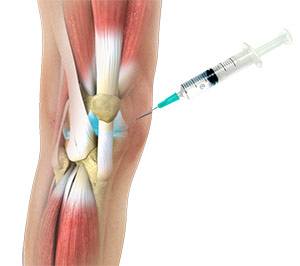
What is Viscosupplementation?
Viscosupplementation refers to the injection of a hyaluronan preparation into the joint. Hyaluronan is a natural substance present in the joint fluid that assists in lubrication. It allows the smooth movement of the cartilage-covered articulating surfaces of the joint.
Indications of Viscosupplementation
Synvisc is one of the most commonly used hyaluronan preparations. It is indicated in the management of shoulder, knee, hip and ankle osteoarthritis that has not responded to non-surgical treatment options such as pain medications, physical therapy, and corticosteroid injections.
Viscosupplementation Procedure
Synvisc provides symptomatic relief and delays the need for surgery. It is injected directly into the joint to replenish the diminished synovial fluid, thereby enhancing its lubricating properties. A single dose or a total of three separate doses of Synvisc, over several weeks, may be required for optimum benefit.
How does Viscosupplementation Work?
The Synvisc injection not only supplements the hyaluronan in the joint but also stimulates the production of hyaluronan in the treated knee. This provides gradual symptomatic relief over the course of the injections. This effect may last for several months.
Post-procedural Care Following Viscosupplementation
Ice packs and an analgesic may be used, if required, to ease any discomfort experienced after the injection. Any strenuous activity such as jogging or sports should be completely avoided for 48 hours to a week after the injection and should be resumed only after consultation with your doctor.
Risks and Complications of Viscosupplementation
You may experience mild pain, swelling, warmth, and redness at the injection site for up to 48 hours following a Synvisc injection. Headache and joint stiffness may also occur in some cases.
Immediately consult your doctor if you develop fever, or the pain and swelling fail to resolve after 48 hours following the injection.
Related Topics
- Knee Arthroscopy
- ACL Reconstruction
- Knee Cartilage Restoration
- Meniscal Surgery
- Patellofemoral Knee Replacement
- Meniscus Replacement
- Cartilage Replacement
- PCL Reconstruction
- Knee Ligament Reconstruction
- Posterolateral Corner (PLC) Reconstruction
- Revision Knee Ligament Reconstruction
- Posterolateral Corner Reconstruction
- LCL Reconstruction
- MCL Reconstruction
- LPFL Reconstruction
- Medial Patellofemoral Ligament Reconstruction
- Quadriceps Tendon Repair
- Knee Fracture Surgery
- Meniscectomy
- Distal Realignment Procedures
- Partial Arthroscopic Meniscectomy
- Patellofemoral Realignment
- Failed Anterior Cruciate Ligament (ACL) Reconstruction
- Failed Meniscus Repair
- Lateral Lengthening
- Meniscal Transplantation
- Prior Meniscectomy
- Tibial Eminence Fracture
- ORIF of the Knee Fracture
- Bone-Patellar Tendon-Bone (BPTB) Autograft
- Bone-Patellar Tendon-Bone (BPTB) Allograft
- Hamstring Autograft
- Hamstring Allograft
- Knee Osteotomy
- High Tibial Osteotomy
- Tibial Tubercle Osteotomy
- Distal Femoral Osteotomy
- Multiligament Reconstruction of the Knee
- Patellar Tendon Repair
- Arthroscopic Reconstruction of the Knee for Ligament Injuries
- Autologous Chondrocyte Implantation
- Partial Meniscectomy
- Cartilage Microfracture
- Pharmacological Interventions for Knee Injuries
- Ultrasound-Guided Genicular Nerve Block
- Intraarticluar Knee Injection
- Viscosupplementation
- Physical Therapy for Knee








